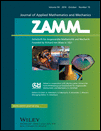A theory of thermoelasticity with diffusion under Green-Naghdi models
Corresponding Author
M. Aouadi
Department of Mathematics and Computer Science, Institut Supérieur des Sciences Appliquées et de Technologie de Mateur, University of Carthage, Tunisia
Department of Mathematics and Computer Science, Institut Supérieur des Sciences Appliquées et de Technologie de Mateur, University of Carthage, TunisiaSearch for more papers by this authorB. Lazzari
Department of Mathematics, University of Bologna, 5 Piazza di Porta S. Donato, 40126 Bologna, Italy
Search for more papers by this authorR. Nibbi
Department of Mathematics, University of Bologna, 5 Piazza di Porta S. Donato, 40126 Bologna, Italy
Search for more papers by this authorCorresponding Author
M. Aouadi
Department of Mathematics and Computer Science, Institut Supérieur des Sciences Appliquées et de Technologie de Mateur, University of Carthage, Tunisia
Department of Mathematics and Computer Science, Institut Supérieur des Sciences Appliquées et de Technologie de Mateur, University of Carthage, TunisiaSearch for more papers by this authorB. Lazzari
Department of Mathematics, University of Bologna, 5 Piazza di Porta S. Donato, 40126 Bologna, Italy
Search for more papers by this authorR. Nibbi
Department of Mathematics, University of Bologna, 5 Piazza di Porta S. Donato, 40126 Bologna, Italy
Search for more papers by this authorAbstract
In this paper, we use the Green-Naghdi theory of thermomechanics of continua to derive a nonlinear theory of thermoelasticity with diffusion of types II and III. This theory permits propagation of both thermal and diffusion waves at finite speeds. The equations of the linear theory are also obtained. With the help of the semigroup theory of linear operators we establish that the linear anisotropic problem is well posed and we study the asymptotic behavior of the solutions. Finally, we investigate the impossibility of the localization in time of solutions.
References
- [1]W. Dreyer and H. Struchtrup, Heat pulse experiments revisited, Contin. Mech. Thermodyn. 5, 3–50 (1993).
- [2]G. Caviglia, A. Morro, and B. Straughan, Thermoelasticity at cryogenic temperatures, Int. J. Nonlinear Mech. 27, 251–263 (1992).
- [3]R.B. Hetnarski and J. Ignaczak, Generalized thermoelasticity, J. Thermal Stresses 22, 451–476 (1999).
- [4]A.E. Green and P.M. Naghdi, A re-examination of the basic postulates of thermomechanics, Proc. R. Soc. Lond. A 432, 171–194 (1991).
- [5]A.E. Green and P.M. Naghdi, A demonstration of consistency of an entropy balance with balance energy, Z. Angew. Math. Phys. 42, 159–168 (1991).
- [6]A.E. Green and P.M. Naghdi, Thermoelasticity without energy dissipation, J. Elast. 31, 189–209 (1993).
- [7]D.S. Chandrasekharaiah, A note on the uniqueness of solution in the linear theory of thermoelasticity without energy dissipation, J. Elast. 43, 279–283 (1996).
- [8]P. Puri and P.M. Jordan, On the propagation of plane waves in type III thermoelastic media, Proc. R. Soc. Lond. A 460, 3203–3221 (2004).
- [9]M. Ciarletta, B. Straughan, and V. Zampoli, Thermo-poroacoustic acceleration waves in elastic materials with voids without energy dissipation, Int. J. Eng. Sci. 45, 736–743 (2007).
- [10]R. Quintanilla and B. Straughan, Growth and uniqueness in thermoelasticity, Proc. R. Soc. Lond. A 456, 1419–1429 (2000).
- [11]R. Quintanilla, Impossibility of localization in linear thermoelasticity, Proc. R. Soc. Lond. A 463, 3311–3322 (2007).
- [12]B. Lazzari and R. Nibbi, On the exponential decay in thermoelasticity without energy dissipation and of type III in the presence of an absorbing boundary, J. Math. Anal. Appl. 338, 317–329 (2008).
- [13]M. Aouadi, Uniqueness and existence theorems in thermoelasticity with voids without energy dissipation, J. Frank. Inst. 349, 128–139 (2012).
- [14]M. Aouadi, B. Lazzari, and R. Nibbi, Exponential decay in thermoelastic materials with voids and dissipative boundary without thermal dissipation, Z. Angew. Math. Phys. 63, 961–973 (2012).
- [15]W. Nowacki, Dynamical problems of thermodiffusion in elastic solids, Proc. Vib. Prob. 15, 105–128 (1974).
- [16]H.H. Sherief, F. Hamza, and H. Saleh, The theory of generalized thermoelastic diffusion, Int. J. Eng. Sci. 42, 591–608 (2004).
- [17]M. Aouadi, The coupled theory of micropolar thermoelastic diffusion, Acta Mech. 208, 181–203 (2009).
- [18]M. Aouadi, Theory of generalized micropolar thermoelastic diffusion under Lord-Shulman model, J. Thermal Stresses 32 923–942 (2009).
- [19]M. Aouadi, A theory of thermoelastic diffusion materials with voids, Z. Angew. Math. Phys. 61, 357–379 (2009).
- [20]M. Aouadi, Qualitative results in the theory of thermoelastic diffusion mixtures, J. Thermal Stresses 33, 595–615 (2010).
- [21]G. Lebon, T. Desaive, and P. Dauby, A unified extended thermodynamics description of diffusion, thermo-diffusion, suspension and porous media, Trans. ASME 73, 16–20 (2006).
- [22]D. Gilbarg and N.S. Trudinger, Elliptic Partial Differential Equations of Second Order (Springer-Verlag, Berlin, 1983).
- [23]A. Pazy, Semigroups of Linear Operators and Applications to Partial Differential Equations. Applied Mathematical Sciences, Vol. 44 (Springer-Verlag, New York, 1983).
- [24]C.M. Dafermos, Contraction Semigroups and Trends to Equilibrium in Continuum Mechanics, in: Applications of Methods of Functional Analysis to Problems in Mechanics, Springer Lectures Notes in Math., Vol. 503, edited by P. German and B. Nayroles (Springer-Verlag, Berlin, 1976), pp. 295–306.
- [25]P.G. Ciarlet, Mathematical Elasticity, Vol. I, Three-Dimensional Elasticity (North-Holland, Amsterdam, 1988).




